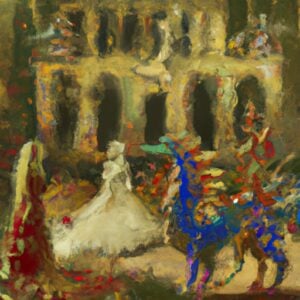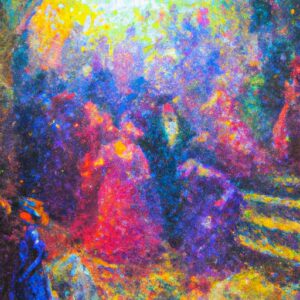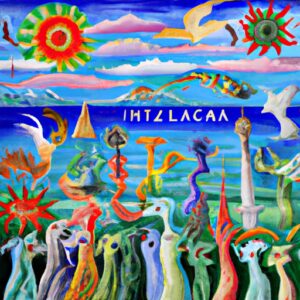Explore the fascinating world of Italian art with our blog! Enhance your artistic knowledge with essential Italian vocabulary. Start learning today!
Exploring Italian Vocabulary Used in Art
Immerse yourself in the world of art and culture as we delve into the fascinating realm of Italian vocabulary used in the art scene. From the captivating works of Leonardo da Vinci to the timeless masterpieces of Michelangelo, Italy has long been hailed as the birthplace of some of the greatest artistic achievements in history.
But what sets Italian art apart? It’s not just the skillful brushstrokes or the meticulous attention to detail; it’s also the language that breathes life into these extraordinary creations.
Common Italian Art Terms and Their Meanings
Italian art is rich in terminology that adds depth and nuance to the understanding of artistic techniques and concepts.
One such term is “chiaroscuro,” which refers to the contrast between light and dark in a painting or drawing. This technique was masterfully employed by artists such as Caravaggio to create dramatic and three-dimensional effects.
Another term, “sfumato,” is associated with the soft blending of colors and tones to create a hazy, atmospheric effect. It was famously used by Leonardo da Vinci in his iconic painting, the Mona Lisa.
Contrapposto is another Italian term commonly used in art, particularly in sculptures. It refers to the pose in which the weight of the body is balanced on one leg, creating a sense of movement and naturalness.
This technique can be seen in many sculptures from the Renaissance period, including Michelangelo’s David. Understanding these terms not only enhances our appreciation of Italian art but also allows us to better articulate our observations and interpretations.
Exploring Color Terminology in Italian Art
Color plays a vital role in Italian art, and understanding the specific terminology used to describe colors can significantly enrich our understanding of artworks.
For example, “rosso” is the Italian word for red, but it also carries connotations of passion and intensity, which is often reflected in the use of this color in Italian art. Similarly, “verde” (green) can symbolize nature, fertility, and hope, as seen in many Italian landscapes.
Italian art also makes use of specific color combinations to evoke certain emotions or create visual harmonies. For instance, the pairing of “rosso e giallo” (red and yellow) can create a sense of warmth and energy, while “blu e bianco” (blue and white) can convey a sense of tranquility and serenity.
By understanding these color associations and combinations, we can better appreciate the intention behind an artist’s choice of palette and the emotions they seek to evoke.
Italian Vocabulary for Different Art Mediums
Italian art encompasses various mediums, including painting, sculpture, architecture, and more. Each medium has its own unique set of vocabulary that helps us understand and discuss the artworks within that medium.
For example, in painting, we encounter terms like “tela” (canvas), “pennello” (brush), and “vernice” (paint), which are essential to the creation of a painting.
In sculpture, Italian vocabulary includes terms like “marmo” (marble), “statua” (statue), and “scalpello” (chisel). These terms not only aid in describing the materials and tools used but also provide insights into the artistic process and the different techniques employed in sculpting.
Architecture, another significant aspect of Italian art, has its own set of vocabulary as well. Terms like “cupola” (dome), “arco” (arch), and “colonnato” (colonnade) are commonly used when discussing Italian architectural masterpieces such as the Pantheon and the Colosseum.
Understanding these terms allows us to appreciate the intricacies of Italian architectural design and the historical significance of these structures.
Famous Italian Artists and Their Contributions to Art
Italy boasts a rich history of influential artists who have made significant contributions to the world of art.
Leonardo da Vinci often considered the epitome of a Renaissance man, is renowned for his unparalleled artistic skills and scientific ingenuity. His works, such as The Last Supper and The Vitruvian Man, continue to captivate audiences with their technical brilliance and profound symbolism.
Michelangelo, another iconic figure in Italian art, is celebrated for his mastery of sculpture, painting, and architecture. His awe-inspiring sculptures, such as the David and the Pietà, showcase his ability to breathe life into stone and capture the human form with unparalleled realism.
Other notable Italian artists include Raphael, known for his graceful and harmonious compositions, Caravaggio, famous for his use of chiaroscuro, and Botticelli, renowned for his ethereal portrayals of mythological subjects.
These artists, among many others, have left an indelible mark on the world of art and continue to inspire generations of artists and art enthusiasts.
Using Italian Art Vocabulary in Conversations and Critiques
In the world of art, discussions, and critiques often revolve around the technical aspects and aesthetic qualities of artworks. By incorporating Italian art vocabulary into these conversations, we can add a layer of sophistication and precision to our analyses.
Using terms like “sfumato” to describe the blending of colors in a painting or “contrapposto” to discuss the pose of a sculpture allows us to communicate our thoughts more effectively and engage in meaningful dialogue with fellow art enthusiasts.
Moreover, incorporating Italian art vocabulary into critiques enables us to articulate our observations and interpretations with greater clarity.
Instead of simply stating that a painting is “beautiful” or “interesting,” we can delve into specifics using terms like “composizione” (composition), “prospettiva” (perspective), or “espressione” (expression). This not only enhances our ability to appreciate and understand art but also enriches our overall artistic vocabulary.
Resources for Further Learning Italian Art Vocabulary
For those eager to deepen their understanding of Italian art vocabulary, there are numerous resources available to aid in this linguistic journey. Online platforms such as art history websites, language learning websites, and art forums provide valuable information and discussions on Italian art terminology.
Books dedicated to Italian art history and techniques also offer comprehensive insights into the vocabulary used in different artistic periods. “Italian Renaissance Art: Understanding its Vocabulary and Techniques” by Robert Williams is an excellent resource for exploring the intricacies of Italian art and its associated terminology.
Additionally, visiting art museums and galleries, both in Italy and around the world, allows us to immerse ourselves in the language of Italian art. Observing the artworks firsthand while referring to their titles and descriptions can enhance our knowledge and familiarity with Italian art vocabulary.
The Influence of Italian Art on the Global Art Scene
Italian art has had a profound influence on the global art scene, with its techniques, styles, and vocabulary permeating various artistic traditions worldwide. The Renaissance, a period of immense artistic achievement in Italy, sparked a revolution in art and paved the way for new artistic practices and ideas.
The techniques developed by Italian masters, such as chiaroscuro and sfumato, have been adopted and adapted by artists across different cultures and periods. These techniques have become universal tools for creating depth, dimension, and atmosphere in artworks.
Furthermore, Italian art vocabulary has become part of the artistic lexicon used by artists, art historians, and critics worldwide.
Terms like “Renaissance,” “fresco,” and “tempera” are now familiar to art enthusiasts across the globe, regardless of their native language. This demonstrates the enduring impact of Italian art and its vocabulary on the broader artistic discourse.
Italian Art Museums and Galleries to Visit
To truly immerse oneself in the world of Italian art and its vocabulary, visiting the museums and galleries that house these masterpieces is a must.
In Italy, the Uffizi Gallery in Florence is a treasure trove of Italian art, housing works by Botticelli, Raphael, and Leonardo da Vinci. The Vatican Museums in Rome are also home to vast collections of Italian art, including Michelangelo’s Sistine Chapel ceiling.
Outside of Italy, the Louvre in Paris exhibits Italian masterpieces like Leonardo’s Mona Lisa and the Winged Victory of Samothrace. The Metropolitan Museum of Art in New York boasts an extensive collection of Italian art, ranging from ancient Roman sculptures to Renaissance paintings.
Visiting these institutions allows us to witness the grandeur and beauty of Italian art firsthand, while also deepening our understanding of the vocabulary associated with these artworks.
Embracing Italian Art Vocabulary to Enhance Your Artistic Knowledge
Italian art has left an indelible mark on the world of art, both in terms of its masterpieces and its rich vocabulary. By delving into the world of Italian art terminology, we gain a deeper understanding of the techniques, concepts, and history that underpin artistic achievements.
Whether we are artists ourselves, art enthusiasts, or simply curious about the language of art, embracing Italian art vocabulary adds a new dimension to our appreciation and understanding of artworks.
From the brushstrokes to the color palette, from the poses to the architectural details, the language of Italian art allows us to unlock the secrets and hidden meanings behind these extraordinary creations.
So, let us embark on this linguistic journey, exploring the captivating world of Italian art vocabulary. Let us immerse ourselves in the words that bring these artworks to life and deepen our connection to the enduring legacy of Italian artistic expression.










3 Responses
Luna, I completely agree with Nicole! The Italian vocabulary used in art is indeed captivating and brings a whole new level of appreciation to artworks. It’s wonderful to see your enthusiasm for learning and exploring this topic. Keep up the great work, and don’t hesitate to reach out if you have any further questions. Thank you for sharing your thoughts! Italian Vocabulary Used in Art.
Luna, I’m glad you found it interesting! Italian vocabulary used in art is truly fascinating and adds a unique dimension to appreciating artworks. Keep exploring and learning, and feel free to ask if you have any more questions. Thank you for your enthusiasm!
This is so interesting! I’ve always wanted to learn more about the Italian vocabulary used in art. Thank you for sharing!